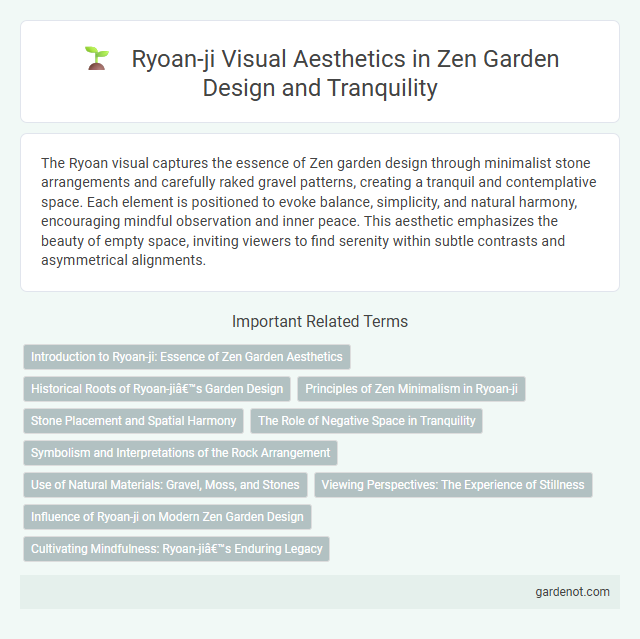The Ryoan visual captures the essence of Zen garden design through minimalist stone arrangements and carefully raked gravel patterns, creating a tranquil and contemplative space. Each element is positioned to evoke balance, simplicity, and natural harmony, encouraging mindful observation and inner peace. This aesthetic emphasizes the beauty of empty space, inviting viewers to find serenity within subtle contrasts and asymmetrical alignments.
Introduction to Ryoan-ji: Essence of Zen Garden Aesthetics
Ryoan-ji exemplifies the essence of Zen garden aesthetics through its minimalist design and carefully arranged stones symbolizing simplicity and tranquility. Its dry landscape garden, or karesansui, emphasizes spatial harmony and meditation, creating a profound visual impact with rocks and raked gravel. This iconic garden reflects Zen principles by inviting contemplative silence and fostering a deep connection with nature.
Historical Roots of Ryoan-ji’s Garden Design
Ryoan-ji's garden design, dating back to the 15th century Muromachi period, exemplifies Zen Buddhist aesthetics emphasizing simplicity and meditation. Its minimalist composition of fifteen carefully placed rocks on white gravel reflects principles of wabi-sabi and Zen philosophy, inviting contemplative stillness. The garden's historical roots highlight the influence of Zen monks and tea ceremony culture, making it a timeless symbol of Japanese spiritual and artistic heritage.
Principles of Zen Minimalism in Ryoan-ji
Ryoan-ji exemplifies Zen minimalism through its strategic use of space, simplicity, and natural elements that foster meditation and mindfulness. The garden's carefully arranged rocks and raked gravel create a balanced composition emphasizing emptiness and asymmetry, embodying the principle of "ma" or negative space. This design encourages viewers to find harmony in simplicity, reflecting the essence of Zen philosophy and the impermanence of life.
Stone Placement and Spatial Harmony
Ryoan-ji's Zen garden exemplifies masterful stone placement, where fifteen stones are strategically arranged on a bed of white gravel to create visual balance and evoke contemplation. The asymmetrical positioning fosters spatial harmony, encouraging viewers to perceive the garden from multiple angles, revealing different groupings and depths. This deliberate design generates a dynamic yet tranquil environment, embodying the essence of Zen aesthetics.
The Role of Negative Space in Tranquility
Ryoan-ji's Zen garden exemplifies the deliberate use of negative space to evoke tranquility and contemplation. The empty areas between the fifteen carefully placed stones create a sense of balance and infinite openness that encourages meditation. This spatial design emphasizes simplicity, allowing the mind to find calm in the interplay between presence and absence.
Symbolism and Interpretations of the Rock Arrangement
The Ryoan-ji Zen garden features fifteen carefully placed rocks symbolizing islands or mountains emerging from a sea of white gravel, representing simplicity and tranquility in Zen philosophy. The deliberate asymmetry and incomplete visibility of the rocks invite contemplation on impermanence and the elusive nature of enlightenment. Interpretations often see the arrangement as a visual metaphor for meditation, encouraging viewers to embrace ambiguity and inner reflection.
Use of Natural Materials: Gravel, Moss, and Stones
Ryoan-ji Zen garden masterfully incorporates natural materials such as meticulously raked gravel, lush moss patches, and carefully placed stones to evoke a sense of tranquility and balance. The gravel symbolizes water or clouds, its raked patterns promoting mindfulness and simplicity, while moss adds softness and life through its green, textured surfaces. Stones, varying in size and shape, are strategically arranged to create harmony and invite contemplation, reflecting Ryoan-ji's core principles of nature and minimalism.
Viewing Perspectives: The Experience of Stillness
The Ryoan-ji Zen garden offers a carefully designed composition of fifteen stones arranged on white gravel, fostering a profound sense of tranquility through minimalism. Viewing the garden from various fixed points reveals shifting perceptions of balance and emptiness, embodying Zen principles of stillness and contemplation. This dynamic experience encourages mindfulness, allowing observers to appreciate spatial harmony and the subtle interplay of form and void.
Influence of Ryoan-ji on Modern Zen Garden Design
Ryoan-ji's minimalist composition of 15 carefully placed rocks on a bed of white gravel exemplifies the essence of Zen aesthetics, profoundly influencing modern Zen garden design by emphasizing simplicity and spatial harmony. Its abstract arrangement encourages contemplation and mindfulness, inspiring contemporary gardeners to incorporate asymmetry and negative space as key elements. This iconic visual archetype drives a meditative atmosphere in modern Zen gardens, promoting tranquility and introspection through understated natural forms.
Cultivating Mindfulness: Ryoan-ji’s Enduring Legacy
Ryoan-ji's iconic Zen garden features fifteen carefully positioned rocks on a bed of meticulously raked white gravel, embodying simplicity and profound tranquility essential for cultivating mindfulness. The strategic placement encourages contemplation, inviting viewers to find balance and clarity through meditation on natural forms and negative space. This enduring legacy of Zen philosophy fosters a deep connection between mind, nature, and the present moment.
Ryoan visual Infographic

 gardenot.com
gardenot.com